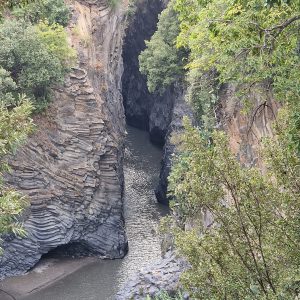One of the most visited tourist attractions not only in the summer, but all year round are the Alcantara Gorges, also known as the Larderia Gorges, located in the Alcantara Valley, between the provinces of Catania and Messina, in the territory that includes the municipalities of Castiglione di Sicilia and Motta Camastra, at the point where the Peloritani mountain chain ends, placed under the protection of the Alcantara River Park, located in the municipality of Francavilla di Sicilia.
A fascinating panorama with unforgettable and enchanting views, with an even romantic purpose. In fact, within the park, the Terrace of Love has been recovered with the famous red Mailbox, in which to post only thoughts and love letters with declarations and wishes written while immersed in the beauty of the Gorges.

What do gorges look like?
These special missives are delivered to their destination by postmen, who turn into true messengers of love. Wonderful stories are born on this terrace and sealed with the padlocks of the Heart. The narrow, very long and very high gorges, an all-Italian geological peculiarity, represent a beautiful natural canyon, formed by black lava walls in prismatic shapes, which were not created by the Alcantara river, but originated from the cooling phenomena of three very ancient basaltic lava flows dated between 25,000 and 9,000 years ago, stratified one on top of the other, which have sculpted rocks in imaginative shapes.
The prismatic structures are of various configurations: ‘woodpile’ (horizontally arranged), ‘harp’ (slightly arched), ‘rosette’ (radial trend) while the most regular formations are vertical, ‘organ pipe’, and can reach up to 30 metres. The name Alcantara derives from the Arabic Al-Qantarah, meaning arched bridge, in reference to an ancient Roman bridge of Arab origin found in the area.
The gorges extend over more than 1,900 hectares between splendid walls up to 50 metres high and 2 to 5 metres wide, with a spectacular conformation and a landscape that alternates between rocks and lush, wild vegetation. The most imposing and well-known gorge is located in Motta Camastra, in the locality of Fondaco Motta, and is more than 6 kilometres long, of which only 3 are passable. There are three main paths within the botanical and geological park of this part of the Alcantara Valley: the Alcantara Gorge path, the Eleonora path and the Mediterranean Garden path.
The first is the classic path that skirts the Gorges from above and begins with a modern 4D multimedia room and the MOL (Museum of Land) exhibition rooms, which provide information on this terrestrial paradise. The path, which is enriched with scale reproductions of some prehistoric animals that lived in the ancient valley and numerous notice boards and educational signs with information and curiosities, ends at the famous little beach of the Gorges, which can be reached by lifts.
The Gorge Trail
During this route, one passes by the Spring of Venus with its characteristic small lake, which marks the beginning of the river’s tumultuous course through the gorges; one goes through the Tumult of Vulcan, where the river violently forces its way through the basalts; one arrives, via a small path, at the Balcony of Venus, in the middle of the gorges, a few metres above river level, surrounded by the looming walls of columnar basalts. An ancient legend tells that the God Vulcan loved, in return, the Goddess Venus and, to seal this love, the God heated the waters of the Alcantara, where the Goddess loved to bathe.

But one fine day, love ended because of Venus’ betrayal, so Vulcan, in a fit of rage and jealousy, made the waters cold and icy. Since then, it is said that the Goddess’ pool restores virility to men and virginity to women who immerse themselves in its cold waters. And again, the Balcony and Amphitheatre of the Muses, where the gorges are about 25 metres high, here you can appreciate the famous organ pipe basalts, smoothed by the strong winter floods of the river.
Shortly afterwards, we reach the Balcony of the Waterfalls, the most intimate overlook in the entire park, from where we can observe the small Grotto of the Gorges, the beach and the small waterfalls, the Prickly Pear Tunnel, so called because of the prickly pear plants that overhang the path, and the Balcony of the Three Mudslides, where we can admire the lava flows dating back some 8,000 years that formed the Gorges: from the oldest, at the bottom, to the most recent, at the top. The Eleonora path, on the other hand, runs along the river downstream, has several overlooks and leads to the small beach of the plane tree via the panoramic staircase, immersed in the Mediterranean maquis.
Along the way are the small Grotta del Daino, which was once used by fallow deer as a natural refuge, and the Platano beach, where a mighty plane tree, a native species of the Alcantara Valley, grows. The Mediterranean Garden Path passes through a lush Sicilian citrus grove and leads to the phyto-purification basins, where you can learn how the natural water purification system works.
There is a legend about the birth of the gorges. It is said, in fact, that the magnificent gorges are actually the work of the wrath of the gods, unleashed by the misbehaviour of a farmer towards his brother, who was blind and from whom he stole part of the harvest by overturning the vessel with which he took the grain. At the end of the harvest, that less-than-honest brother had an abundance of grain, while the other had very little left.
So the gods flew into a rage and hurled a thunderbolt at the farmer that killed him and turned his heap of grain into a mountain of brown earth, which began to erupt an enormous quantity of lava that covered the entire valley.
The Botanical and Geological Park of the Alcantara Gorge falls within the Alcantara River Park and was created in the 1960s to spread knowledge of one of Sicily’s most magical places. It covers about 100 hectares of citrus groves, olive groves, pastures, forests, typical flora and fauna, with typical hazelnut groves, prickly pears chestnut trees, olive trees, willows, poplars, birch trees, flowers such as anemones, violets, orchids and poppies, fish such as trout, tench, carp and eel, birds such as grey crows, Kentish plovers and kingfishers, amphibians such as the green frog and the emerald toad, and rare animals such as the painted discoglossus (a frog), the marten and the weasel.
Today, all traditional agricultural activities are practised in the park for the cultivation of citrus and olive trees, which are processed directly on site to obtain citrus or herbal liqueurs, jams, PDO olive oil and many other genuine products. The Gorges, which in 2010 received European Destination of Excellence (EDEN) recognition, can only be visited on foot, and there are many attractions and alternative activities that can be tried.
Sports
Those who love adventurous sports and hiking can choose canyoning, body rafting with wetsuit, helmet and life jacket, with river specialists, river trekking with specialised guides, or you can visit the park on a quad bike, mountain bike or electric bus. For children, there is baby rafting and the Spray Park with colourful slides, water jets, fountains and many other water games.
The Gorges, due to their beauty and charm, have also been used as partial locations for various film productions, such as L’arcidiavolo (1966) by Ettore Scola, I paladini: storia d’armi e d’amori (1983) by Giacomo Battiato and Il racconto dei racconti – Tale of Tales by Matteo Garrone.
What to visit after seeing the Gorges
Immediately after your visit to the Alcantara, you can stay in the area and see Castiglione di Sicilia, a hillside town listed among the most beautiful villages in Italy, Motta Camastra, a pretty hillside village with a splendid view of the Valley, the Gurne, 16 small enchanting lakes, where you can go body rafting, swimming and sunbathing, and the Arab Castle, a ruin from the Arab-Norman era located on a hill with a breathtaking view of the green Alcantara Valley.
In addition, not far from the Gorges, there are the Piccole Gole with the same basalt cliffs, but much smaller, about 5/10 metres high, located near the Cuba of Santa Domenica, a beautiful Byzantine church dating back to the 7th century A.D., a national monument since 31 August 1909.
foto credits Gole alcantara parco Botanico


